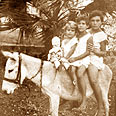
Kinneret colony celebrates 100th anniversary
Zionist-settlement enterprise launched near Jordan River's point of departure from Sea of Galilee after agronomist Kalvarisky purchases lands in area. Ynet presents four-part series documenting lives of first families that settled in village
At the beginning of the 20th century, agronomist Haim Margaliot Kalvarisky, who was in charge of founding the Galilee colonies on behalf of the Jewish Colonization Association (JCA), purchased lands in the Yavne'el Valley, where the colony of Yavne'el was later founded.
In 1904, Kalvarisky encountered an opportunity to purchase the lands of Delaika (where the Kinneret Farm was later built).
He put a down payment for more than 12,000 dunam (2,965 acres) in the area, and when he asked the JCA to accept the land, its members refused, claiming that he did not consult them before striking the deal.
Kalvarisky then turned to Arthur Ruppin, who headed the Palestine Bureau (also known as "Eretz Yisrael Office") of the World Zionist Organization, and Ruppin recruited Zionist men of means to help buy the land.
In 1908, following a recommendation by agronomist Berman, the Kinneret Farm was built in the area. The Israel Land Development Co. (ILDC) and its emissary Arthur Ruppin planned to have this facility train the pioneers arriving in Israel to establish farms.
North of the Kinneret Farm, the JCA purchased a strip of land for the establishment of the Kinneret colony, which would include eight peasant courts.
This week we launch a series of four articles featuring the story of the first families who settled in the area and live there to this day.
The photos are documented in the houses of the pioneers and in the colony's museum.
We would like to thank Mulik (Shmuel) Yizraeli, whose family was one of the founders and who treasures the days of the colony in his memories.
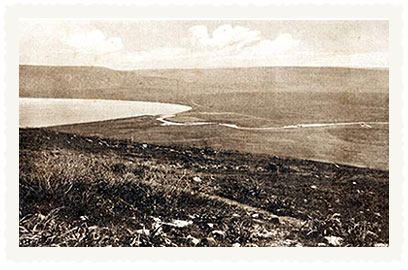
1. A photographed postcard of Ben-Dov: The Jordan River's point of departure from Lake Kinneret at the beginning of the 20th century, when the land purchase began. Delaika, a wild Bedouin tribe, forcibly controlled the area through robbery and murder. Passing by unprotected was dangerous.

2. A photographed postcard of Ben-Dov from the foundation of the Kinneret colony: The pioneers who arrived at the Kinneret Farm are seen hard at work. The large two-story building on the left is in the yard of Kinneret Farm. On the back and right you can see the peasants' houses built by the JCA for the Kinneret farmers. The large house on the right is the Treidel home.
The three Treidel brothers were Yoop, Alfred and Oscar. Yoop, the oldest one, studied agricultural engineering in Germany and arrived in the Land of Israel in 1898. He and Ephraim Krause (the brother of Eliyahu Krause, the manager of the Sajera farm and Mikveh Israel), founded a technical office together the ILDC, and the JCA hired their office's measurement and supervision services.
Alfred, the second brother, studied agronomy and sent the funds he received as wedding presents to his brother Yoop in the Land of Israel, asking that he purchase land for him. Yup, who was busy measuring land for the Kinneret colony at the time, purchased and built the house seen in the photo. Part of the house was a hotel for dignitaries who arrived at the area (Baron Rothschild would also stay at the place during his visits).
On important detail seen in the picture is the Jordan's River's point of departure from Lake Kinneret, which at the time was located between the Kinneret Farm hill and Tel Bet Yerah (Khirbet Kerak). The riverbed was clogged and the river's departure point moved south to where it is today.

3. A photographed postcard of Ben-Dov from the foundation of the Kinneret colony: The photo was taken from the mountain west of the colony. The village of Tzemach is seen in the distance, beyond Lake Kinneret. On the right, near the lake, is the Kinneret Farm. In the front is the only street, filled with the houses of the colony's farmers.
The tall building on the right is the clinic. The first person to live there was medical assistant Naomi Shapira, who was replaced in 1911 by Yaakov Hefetz. A year later, a two story-building was built on the other side of the road, serving as a kindergarten and school for the colony's children.

4. A postcard from Ben-Dov: "Cucumber field in Kinneret" (each plant is raised inside a box)
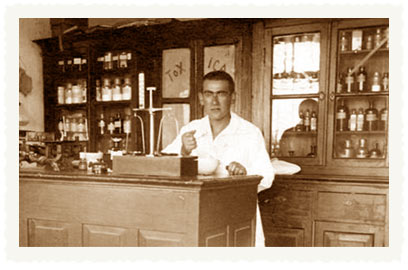
5. Yaakov Hefetz at the Kinneret clinic
Yaakov Hefetz was born in 1887 in the town of Pochep in Ukraine, where he also studied pharmaceutics. He immigrated to Israel in 1908 and began working at the orchard of his friend Ginsin in Petah Tikva. In 1911 he arrived at Kinnert to replace medical assistant Naomi Shapira. He married Pua Lis, who was at the Alamot Farm in Kinneret.
Hefetz was a medical assistant in his profession, but during his years in Kinneret he was in fact the doctor of the colony and the surrounding communities. In those first years, the common diseases were malaria, cholera and typhus. The lives of many of the residents were saved thanks to Yaakov's activity.
Pua and Yaakov's children were Nehama, Ziva, Ruthy, Nitza and Yitzhak. Yaakov died in 1978 at the age of 91, and Pua passed away in 1981 at the age of 88.
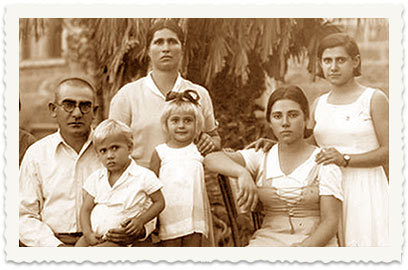
6. 1934, The Hefetz family on the backdrop of the clinic. From the right: Ziva, Nehama, Nitza, Pua, Yitzhak and Yaakov
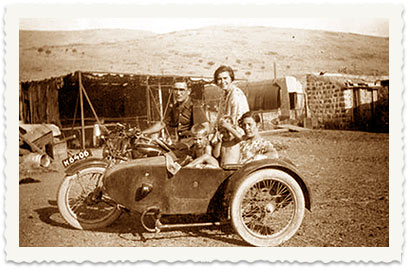
7. Transportation improved – from a donkey to a motorcycle with a sidecar. In the photo: The family on the motorcycle

8. Near the Hefetz house, summer of 1925. From the right: Ziva, Ruthy and Nehama

9. Nehama Hefetz washes Yitzhak, 1933

10. Yoav Halevy and Ziva Hefetz near the school building, 1930s
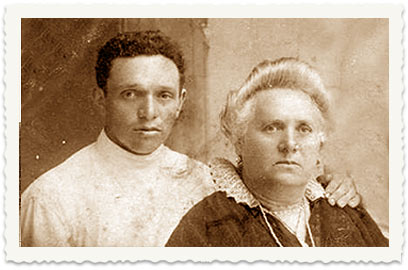
11. The first peasants' house near the clinic was the Halevy home. In the photo: Nahum Levin (Halevy) with his mother Rachel
Nahum (Levin) Levy immigrated to the Land of Israel from Ukraine in 1906. He worked in different places: Stein's casting factory in Jaffa, the Rishon Lezion winery, the farm of Yaakov Shertok (Moshe Sharet's father) in Ein Sinia near Jerusalem, with a group of builders in Jerusalem, in Gdera and in Zichron Yaacov.
He eventually arrived at the Mitzpe colony, where he married Miriam Glikin in 1912. Nahum and Miriam sought to move from Mitzpe to Kinneret, and their wish came true only after Yosef Tseitlin's farm was made available.
Their daughter Drora was born in March 1913, and was the first baby girl of the Kinneret colony. Their other children were Yova, Amihai and Tuvia. Amihai was killed at the age of 20 in November 1941 in an ambush placed by Arab murderers to a group of the colony's residents who were on their way to Tiberias. Miriam passed away in 1951 and Nahum in 1963.
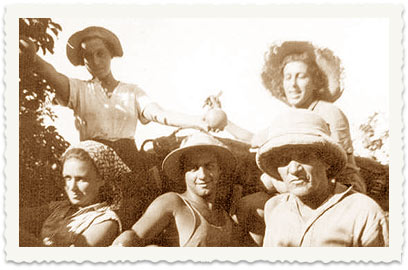
12. On the right: Nahum Halevy
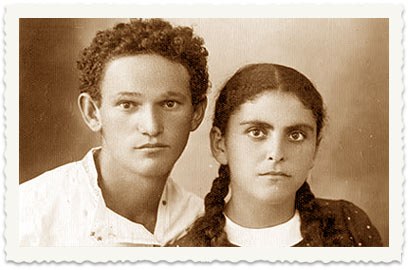
13. Tzipora and Yoav Halevy, 1940

14. Amihai Halevy
The family members appearing in these articles and their friends are invited to add information through the talkback feature.
- For all trips to the past – click here










